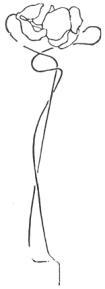
Pictures
in Colour
of
The Isle of
Wight.
WITH
DESCRIPTIVE NOTES.
Project Gutenberg's Pictures in Colour of the Isle of Wight, by Various This eBook is for the use of anyone anywhere at no cost and with almost no restrictions whatsoever. You may copy it, give it away or re-use it under the terms of the Project Gutenberg License included with this eBook or online at www.gutenberg.net Title: Pictures in Colour of the Isle of Wight Author: Various Editor: Jarrold & Sons Release Date: December 13, 2005 [EBook #17296] Language: English Character set encoding: ISO-8859-1 *** START OF THIS PROJECT GUTENBERG EBOOK PICTURES IN COLOUR *** Produced by Robert J. Hall

|
Pictures
|
CONTAINING FIFTY BEAUTIFULLY
COLOURED PICTURES OF
THE ISLE OF WIGHT.
JARROLD & SONS, LTD.
10 & 11, Warwick Lane, E.C.
London & Exchange Streets,
Norwich.
Pictures in Colour
of Isle of Wight.
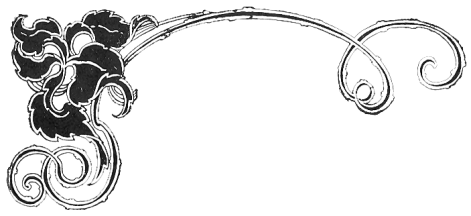
Among the numerous holiday resorts which claim the attention of the travelling public, the Isle of Wight will be found to possess attractions of very varied character. It has often been the theme of poets and the delight of artists. The student of art and the amateur photographer can find subjects in variety, whatever may be his peculiar line of study. The noble cliffs and bays for the student of coast scenery; old mills and cottages, with trees and streams, for the lover of sylvan beauty. The rugged grandeur of the Landslip and Undercliff will furnish subjects that yield delight in the interpretation of their romantic interest. The earnest student of Geology will find enhanced interest in the fact that within short distances many successive formations can be studied; the high inclination of the strata bringing to the surface the different formations. The gentle undulations of the land also furnish great opportunities for pictorial expression. The Botanist may here find an almost inexhaustible store of treasures. Wild flowers and ferns abound in great variety.
To those who have never visited the Island, the accompanying illustrations will unfold sufficient of its beauty to give some idea of its resources. Being reproductions from actual photographs they may be relied upon as being true to Nature. There is great diversity in the scenery, and a holiday can be enjoyed amid its beauties which can scarcely be surpassed. It may be truly described as the Garden of England, and some of its scenes are here presented in the hope that those who inspect its beauties as here transcribed will be induced to visit and see it for themselves.
Steephill Castle, Ventnor.

STEEPHILL CASTLE, VENTNOR.—Within a mile of Ventnor, and close to the Town Station of the Isle of Wight Central Railway, is Steephill Castle with its beautiful and extensive grounds. From every point outside the Castle is well embowered in trees, only the tower being visible. It was built in 1835 by I. Hambrough, Esq. The architectural features are well displayed from inside the garden. The view from the tower is very fine. In 1874 the Empress of Austria stayed here, and hunted with the Isle of Wight hounds during her visit. It is occupied at the present time by Mr. and Mrs. Morgan Richards, the parents of "John Oliver Hobbes" (Mrs. Craigie), who is a frequent visitor.
Appuldurcombe Abbey.

APPULDURCOMBE ABBEY.—The ancient seat of the Worsley family, the present building was erected in the eighteenth century by Sir Robert Worsley. Here the Benedictine monks had a Priory in the time of Henry III. It was dissolved by Henry V, Sir Richard Worsley died in 1805, and the house became the property of the Earl of Yarborough, who had married the niece and heiress of the family. After being used as a school for many years, it is now occupied by Benedictine monks, In a beautiful park of four hundred acres, with a lofty down behind it, the house appears to be a well secluded and charming retreat. There is a public footpath through the meadow in front of the house.
Steephill Cove,
near Ventnor.

STEEPHILL COVE, NEAR VENTNOR.—Taking the cliff path from Ventnor to the west within a little more than a mile there opens out to view this pretty Cove. It is a place for painters, and its loveliness in all varieties of Nature's many moods, has found admirers. The cottages nestling under the banks, its parti-coloured gardens, with enclosing pebble walls, its boats and crab-pots, with the distant cliffs in succession, all combine in a composition that strikes the beholder with a conviction of its beauty.
Shanklin Esplanade,
from Rylstone.

SHANKLIN ESPLANADE, FROM RYLSTONE.—This favourite view, which shews nearly the whole of Shanklin Pier, also includes in the distance the Culver Cliff. Taken from the Garden of Rylstone, overlooking the foot of the Chine, it forms a most attractive scene. The cliff pathway on the green to the right, the winding road and broad esplanade, with the wide expanse of sands, furnish a characteristic view of the principal features of Shanklin front. The level sands form a safe and pleasant bathing-ground when covered by the sea. Boating too is popular, it being within easy reach of beautiful bays in the direction of Luccombe.
Gateway,
Carisbrooke Castle.

GATEWAY, CARISBROOKE CASTLE.—This noble gateway tower was erected by Anthony Woodville, Lord Scales, in the year 1464, and is still in good preservation. The outer gateway was erected in the time of Queen Elizabeth, when a great extension of the grounds enclosed was made.
"The battled towers, the dungeon keep,
The loop-hole grates where captives weep,
The flanking walls that round it sweep
In yellow lustre shone." (Scott).
The old massive doors have been removed recently and replaced by a lighter structure.
Osborne House Terrace.

OSBORNE HOUSE.—This view of Osborne from the south lawn is the most picturesque, and gives the late Queen's apartments standing out in bold relief in the centre of the picture. The terraces below adorn the building, and the rosary which extends on the right to the lawn is gay with a blaze of colour in the month of June. Now that Osborne has been made into a Naval College, the grounds are open to visitors on Fridays in the winter, and on Tuesdays and Fridays in the summer season; it is visited by many thousands during the year.
The Pond, Bonchurch.

THE POND, BONCHURCH.—One of the show places of the Isle of Wight known throughout the world by the lovely pictures that have been made of it. It has lately fallen into disrepute by the destruction of some of its beautiful trees, but more specially by the leakage of the pond which left it stagnant, dirty, and partly dry. This has now to a large extent been remedied, and the pond once more assumes its former aspect, giving reflection in its surface to the lovely forms of beautiful foliage with which it is overhung. The village is one mile from Ventnor.
St. Catherine's Lighthouse.

ST. CATHERINE'S LIGHTHOUSE.—Formerly the Lighthouse stood upon the Downs, but the prevalence of sea mists during certain portions of the year which obscured the light, at last led to the erection of the present building near the margin of the sea. It is one of the most powerful lights in the world, sending its rays far out over the sea and land as it revolves. When the sea mists arise it has a powerful foghorn which can be heard for many miles. Close by is the reef at Rockenend, on which many a gallant ship has been broken up.
Ferncliffe Pleasure Gardens,
Sandown.

FERNCLIFFE PLEASURE GARDENS, SANDOWN.—These beautiful grounds have lately been acquired by a syndicate of leading residents, with the view of their ultimate acquisition for the town. The house is available for refreshments, and the Gardens, which are well wooded, are pleasant to ramble in. There are little nooks and seats overlooking the bay in several directions. It is already proving a great attraction to the town.
The Needles.

THE NEEDLES.—When walking on the Downs from freshwater to the Needles, following the path by the military fence, this picture of the Needles comes suddenly into view, and is a very impressive sight. The Needles themselves are stacks of upper chalk, with flints, and are the remains of an extension of the chalk. The cliffs here are about four hundred feet in height, and at their base the sea breaks frequently in a long surf line on the steep shingly shore. In calm weather visitors engage boatmen at Totland and Alum Bays to take them in boats through the Needles and land them in Scratchels Bay.
Shanklin Old Village.

SHANKLIN OLD VILLAGE.—One of the most charming old-world pictures, which still retains its rustic simplicity. Multitudes of visitors from all parts of the world yearly visit this relic of Old Shanklin. Pretty thatched cottages can be seen in many parts of the Island, but nowhere is there such a combination, there being three different styles of roof in thatch, the setting in a background of trees completing the illusion of the country. In the angle where the figures stand is the rustic fountain on which hangs the shield with the verse written by the poet Longfellow when staying at Hollier's Hotel, Shanklin, in 1869.
"O traveller, stay thy weary feet,
Drink of this fountain cool and sweet,
It flows for rich and poor the same:
Then go thy way, remembering still
The wayside well beneath the hill,
The cup of water in His name."
Stone Bridge in
Shanklin Chine.

STONE BRIDGE IN SHANKLIN CHINE.—About half-way through the Chine the ravine is spanned by an arched Stone Bridge which, in conjunction with the steep banks with trees and ferns, makes a fine pictorial effect. Many of the trees are a great height, having been drawn up in seeking the light above the cliffs, which in this place are a considerable height. The stream flows along the narrow channel under the bridge.
Chine Hollow, Shanklin.

CHINE HOLLOW, SHANKLIN.—This charming lane leads from Shanklin Chine direct to the Landslip. Close to the head of the Chine and within two minutes' walk of the Old Village it forms a beautiful shady retreat on a summer day. The steep banks are of bright red and yellow sandrock beds, out of which trees have grown and verdant vegetation has found a footing until the whole is covered with Nature's mantle of beauty. The view is taken coming from the Landslip and looking towards the Chine, Old Village, and town.
View Across the Foot of Shanklin Chine.

VIEW ACROSS THE FOOT OF SHANKLIN CHINE.—From the shelter of a pretty nook in which seats are provided, Shanklin sands and cliffs appear in all their exquisite beauty. A wide stretch of sand from the foot of the Chine to the fine cliffs of lower Greensand supplies a playground for multitudes of happy children. Under the cliff is a happy camping-ground, in which numerous tents are put up in the season. The fisherman's cottage, with its rough stone walls and roof of thatch, forms a pleasing subject in many a picture. Half-way to the cliff are steps leading up to Appley Cliff into the village, or on to the Landslip.
Shanklin Chine.
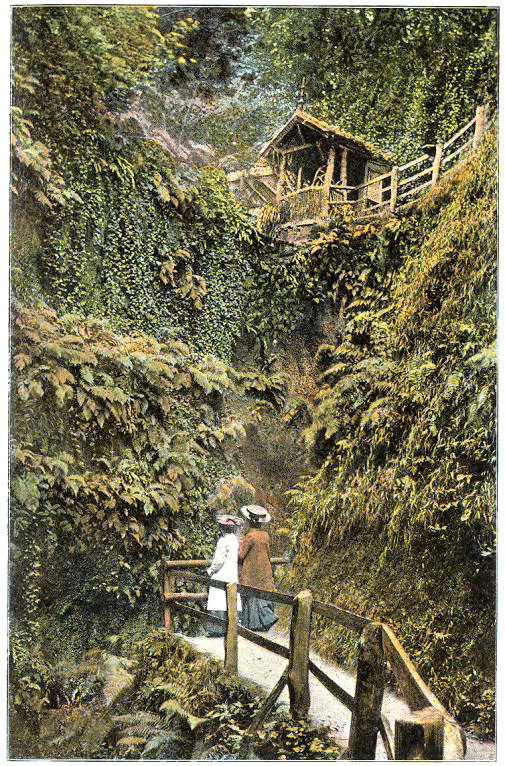
SHANKLIN CHINE.—A scene of sylvan loveliness beyond description. Winding paths extending from the shore for about one hundred yards, through one continuous bower of beauty, bring you to the head where in the wet season there is a cascade. In the summer the banks are one mass of ferns and foliage of varied form and colours. Quiet nooks are to be found where, during the heat of the day, a book can be enjoyed in the cool shade of the trees. Shanklin has the reputation of being the cleanest town in England. It is certainly the most beautiful in the Isle of Wight.
Stone Seat—
The Landslip.

STONE SEAT—THE LANDSLIP.—The Landslip which lies between Shanklin and Ventnor is a favourite resort to the inhabitants and visitors of both places. The catastrophe that wrought this magic transformation has resulted in producing scenery of entrancing beauty. The efforts of Nature to cover and hide the deformities of riven rocks and yawning chasms have produced trees of fantastic shape and remarkable diversity. The broken rocks afford sustenance for many plants, the chloritic marl liberated making the ground wonderfully fertile. This stone seat forms a natural throne on which many parties have found a trysting-place. As it stands in the principal pathway it is a well-known resting-place.
On the Road to Blackgang.
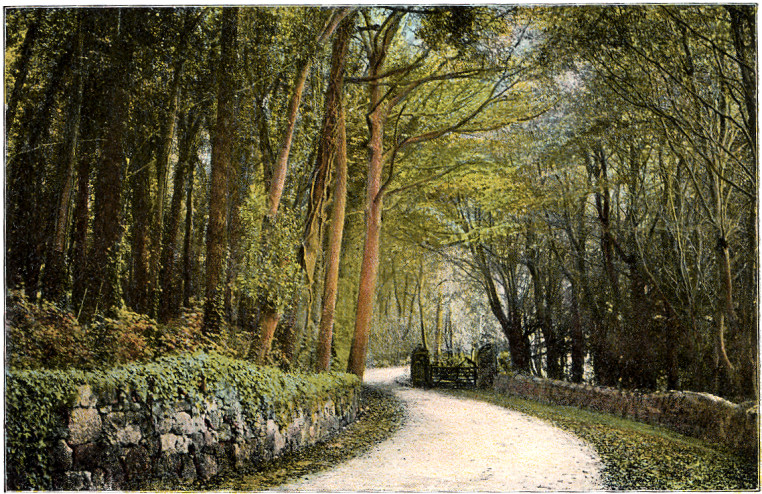
ON THE ROAD TO BLACKGANG.—"One of the most charming drives in England," is the verdict of many visitors to the far-famed Undercliff, as they go through shady groves and again emerge under the weather-worn craggy cliffs above the road. In spring the ground under the trees is carpeted with flowers, and the winding road uphill and down creates a transformation scene at every turn. There is no rest for the eye, and all the faculties are awake to enjoy a new sensation of delight as each corner in the road is turned. It is a perfect fairy land, and the rugged walls are half hidden by multitudes of plants which enhance the lights upon the stone.
Windy Corner—
The Undercliff.
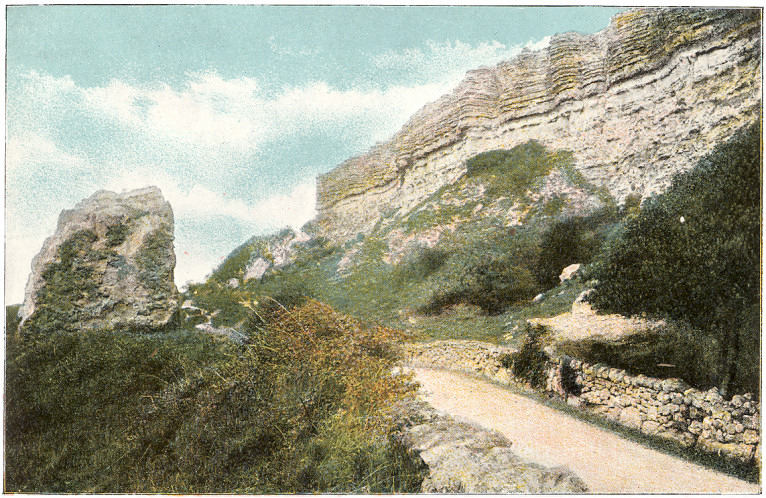
WINDY CORNER—THE UNDERCLIFF.—One of the most romantic districts in the whole of England is the Undercliff, extending for five miles from Ventnor to Blackgang Chine. Its beauty has been caused by the slipping away of the Gault clay, letting down the masses of Upper Greensand rock. The chert beds of the cliff have been weathered out by wind and rain into forms of rugged beauty, while the broken and undulating ground below is filled with flowers and vegetation of the most wonderful and varied character, scattered rocks peeping out among the foliage furnishing bits of a most attractive character to the artist and photographer.
Ventnor, looking East.

VENTNOR, LOOKING EAST.—The differences of elevation afford to most of the houses in Ventnor practically uninterrupted views of the sea. The sheltered nature of the site also furnishes a most congenial climate, in which plants and shrubs in great variety flourish. The horned poppy adorns the cliffs, and valerian and tamarisk thrive even during the winter months. Its peculiarities of climate and position render it a highly favourable residence for invalids throughout the year. It would be difficult to name any place of equal extent and variety of surface, or of equal beauty in point of scenery—so completely screened from the cutting N.E. winds of spring.
Ventnor, from the Sea.
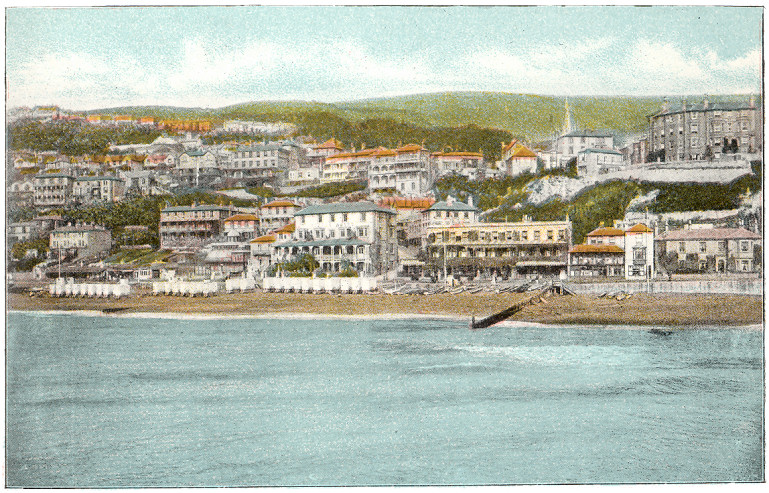
VENTNOR, FROM THE SEA.—Built on the slopes of the hill, Ventnor presents from the sea a remarkable and magnificent picture. Each house being at a different elevation, commands sunshine all the day. Sheltered from the cold wind, trees and flowers flourish and retain their beauty during the winter. When the golden gorse and purple heather are in bloom upon the downs it forms a most attractive scene. Steamboat trips daily during the summer furnish the visitors with abundant opportunities of enjoying this vision of beauty. The Railway Station lies between the hills behind the Church spire. The Town Station of the Isle of Wight Central Railway lies to the left beyond the Park.
Ventnor, looking West.

VENTNOR, LOOKING WEST.—From this point Ventnor is beautiful both in summer and in winter. The setting sun on a winter day is a sight worth travelling far to see, and in summer the white chalk cliffs of the foreground are clothed with crimson valerian, mingled with bright green samphire, while the gardens below, with the miniature lake, are full of colour. These effects, together with the houses perched on every conceivable vantage point of rock and surrounded with vegetation of varied hue, make up a picture of entrancing beauty. There is a good Pier for promenading and fishing as well as for steamboat excursions.
Old Oak Tree—
The Landslip.
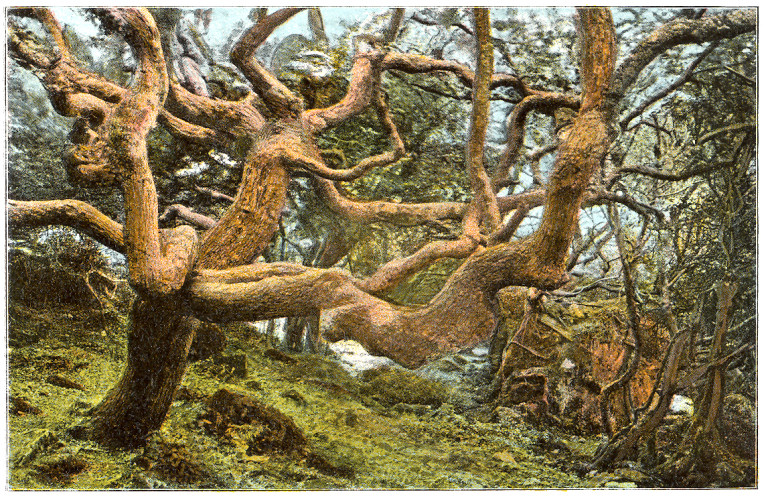
OLD OAK TREE—THE LANDSLIP.—This is one of the many specimens of fantastic growth to be found in the Landslip, and is a great contrast to the tall and stately beech trees that grow in the Cloisters nearer to the upper cliff. It resembles very much the serpent-tree which was painted by Turner. This part of the Landslip is full of great diversities of form and situation, some appearing to grow direct out of the rocks. The white scented violet grows here in great profusion in April.
Blackgang Chine.

BLACKGANG CHINE.—This view of Blackgang exhibits its wild and rugged grandeur. The cliffs rise to a height of four hundred feet above sea level. The surf-line breaking on the red beach far below on the left, with the broad expanse of sea beyond, is very fine. The cliffs in the middle distance consist of the sands and clays of the lower Greensand formation, and are constantly falling and being eroded by the waves. The breakers on the shore at Blackgang are very grand in stormy weather, the beach being very steep and the water deep outside, a great volume rolls in with magnificent effect and thunderous sound. Geologically it is of great interest, the beds of the lower Greensand being more fully developed here than elsewhere, a thickness of almost eight hundred feet being exhibited in this neighbourhood.
Swiss Cottage, Osborne.
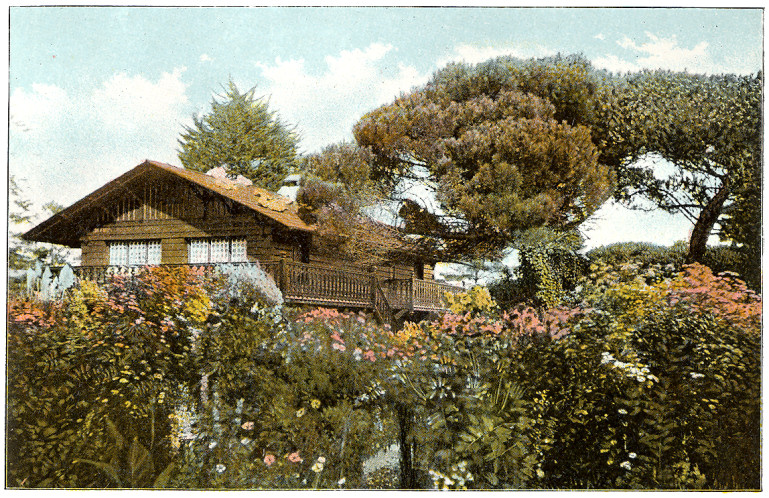
SWISS COTTAGE, OSBORNE.—The grounds of Osborne House contain five thousand acres, the lawn sloping down to the sea adjoining the grounds of Norris Castle. A sheltered portion of the garden contains a large number of trees and shrubs from Indian and foreign climes. In the vicinity of this Indian garden is Swiss Cottage, forming an architectural contrast to Osborne House, and surrounded with trees and flowers that make it appear quite a little paradise.
The Floating Bridge, Cowes.
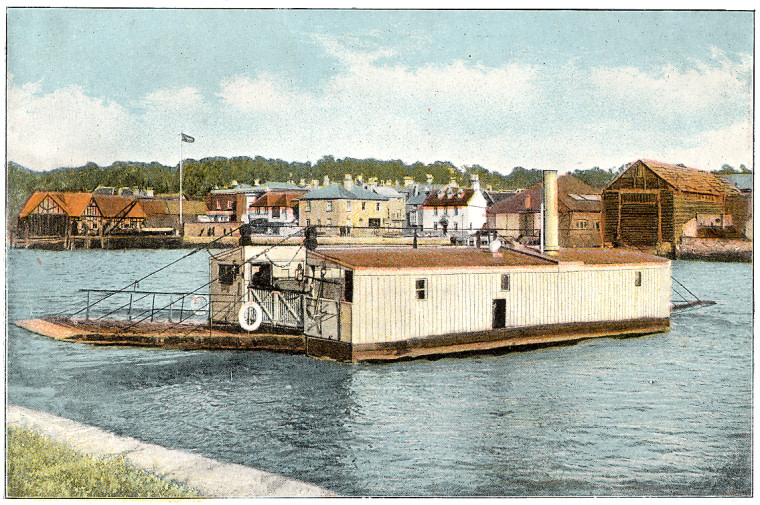
THE FLOATING BRIDGE, COWES.—East Cowes is reached by crossing in this bridge, which goes backwards and forwards across the mouth of the Medina, conveying carts, carriages, coaches, and motor cars, as well as passengers. It works on chains which pass under it, fastened to the shore at each end. It is a novel experience to many people when they find the coachman drive his four-horse coach full of passengers down the slope on to the bridge, and then off again at the other side.
Whippingham Church.
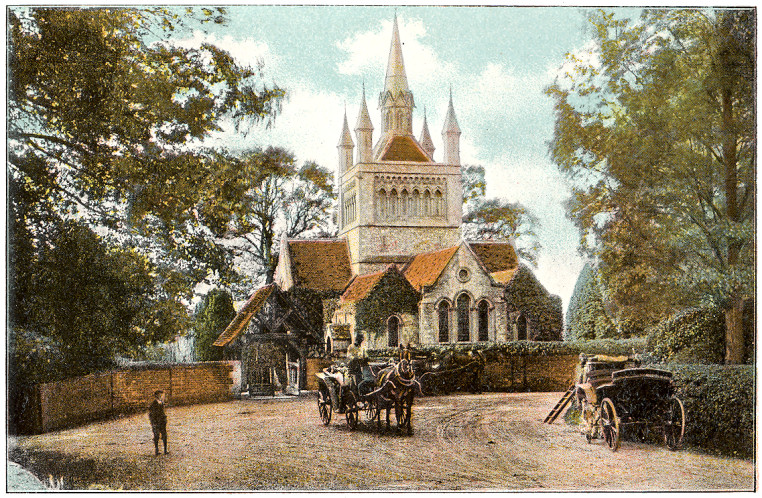
WHIPPINGHAM CHURCH.—About a mile south of Osborne is Whippingham Church, a cruciform structure from designs furnished by the late Prince Consort. Before a private Chapel was added at Osborne the Royal Family often attended. The aisles which contain seats for the Royal Household are divided from the Chancel by ornamented arcades. The north aisle is converted into a Mortuary Chapel in memory of Prince Henry of Battenberg. Mural tablets to Princess Alice, the Duke of Albany, and a medallion bust to the Prince Consort have been erected by Her late Majesty; also a medallion to Sir Henry Ponsonby, whose tomb is in the Churchyard. From the back of the Church there is a fine view of the river Medina, looking towards Newport, the capital of the Island.
The Pier, Cowes.
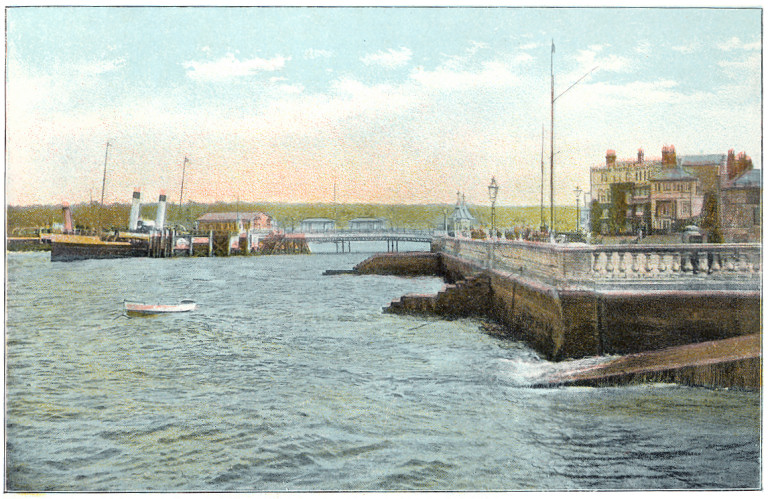
THE PIER, COWES.—The new Pier and Esplanade from an attractive feature at Cowes. When emerging from its narrow streets you come out into the wide open expanse of Esplanade, it is a great relief. The Marine Hotel forms a prominent object. East Cowes is to be seen in the distance. This view is taken from close to the entrance to the Royal Yacht Squadron Grounds and Landing Stage.
Royal Yacht Squadron Club House, Cowes.
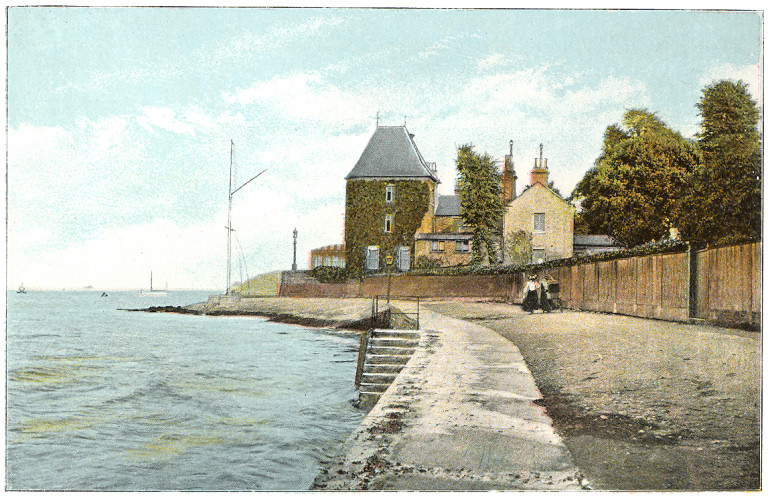
ROYAL YACHT SQUADRON CLUB HOUSE, COWES.—The Club House was originally one of the fortresses built by Henry VIII. for the defence of the Island. In the time of Charles I. it became a prison. It is now rented from the Commissioners of Woods and forests by the Club. It is a scene of gaiety and animation during the first week in August, which is the Cowes week of the season. Crowds gather near the slipway to see the royal and noble passengers land when the yachting season is on. The Causeway leads to the Green which is crowded during the racing. On fireworks-night this thoroughfare is densely packed from end to end.
High Street and
Queen Victoria Memorial, Newport.
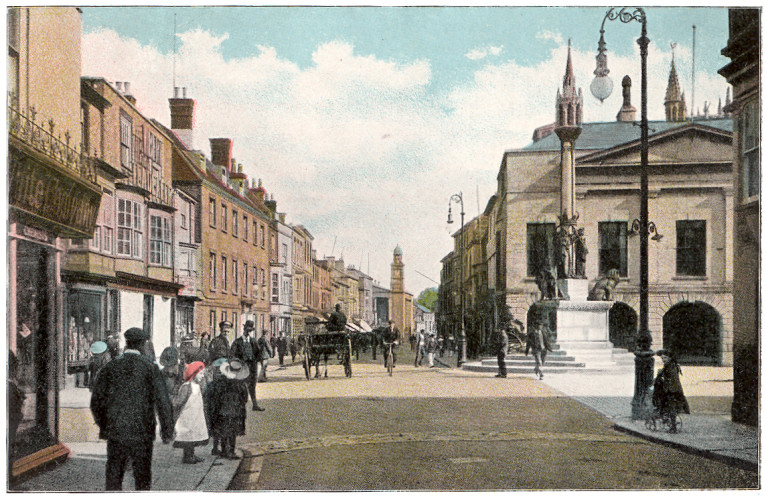
HIGH STREET AND QUEEN VICTORIA MEMORIAL, NEWPORT.—The ancient borough of Newport is the capital of the Island. Its streets are usually busy, and on market days are quite gay and animated. The County Petty Sessional Court is held every Saturday in the Town Hall, which is also the meeting-place of the Town Council. The Isle of Wight County Council meets at the Technical Institute, as does also the Education Authority. In the same building is the Free Library, the gift of Sir Charles Seeley, Bart., who also pays the librarian's salary, with the water rent secured from the Town Council for the splendid supply, recently acquired from the estate of Sir Charles at Bowcombe. The Diamond Jubilee Memorial to Her late Majesty is erected on the spot where at the Jubilee, in 1887, Her Royal Highness received an address of congratulation from the inhabitants of the Isle of Wight. Newport contains the old Grammar School where Charles I. held his conference with representatives of the Parliament, and many other buildings of historical interest. The monument to the Princess Elizabeth, daughter of Charles I., is in St. Thomas' Church.
Steps to the Keep,
Carisbrooke Castle.
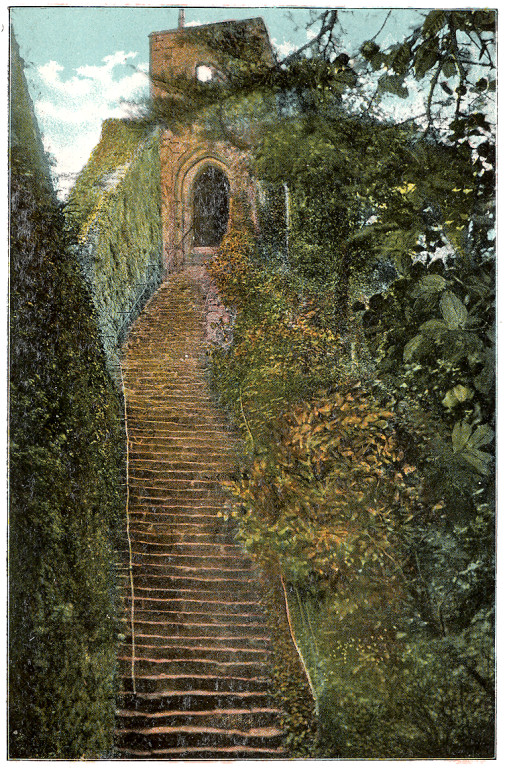
STEPS TO THE KEEP, CARISBROOKE CASTLE.—As a memorial of a bygone age how interesting are the steps to the keep, the last resort of the besieged, from which it would be difficult to dislodge them, without great loss. The well which furnished them with water is now dry, but can still be seen. The battlements furnish the visitor with a magnificent view of the country in every direction. The steps, seventy-two in number, are somewhat steep. The walls are covered with climbing plants. Shelter is afforded by trees and bushes, while access is given at the back of the ancient buildings in the Castle, to facilitate escape in case of surprise.
Carisbrooke Village.
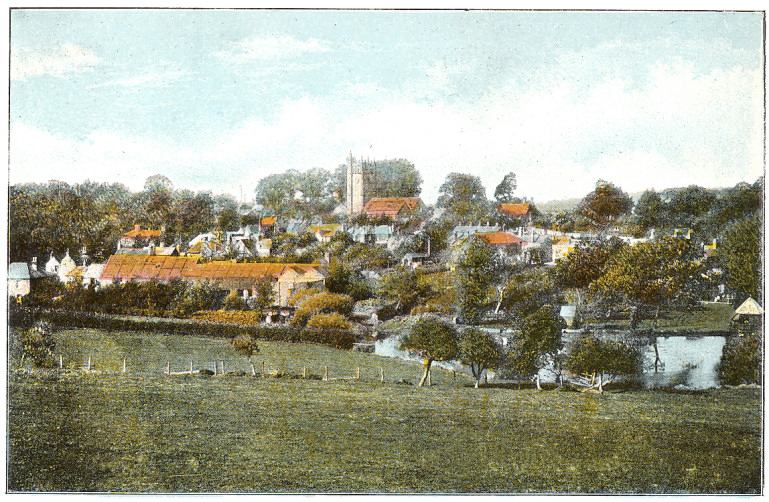
CARISBROOKE VILLAGE.—The village of Carisbrooke is beautifully situated. The Church, embowered among the trees, stands on an elevated site close to the Priory, with which it was associated. The Chancel was destroyed in Queen Elizabeth's reign by Lord Walsingham, whose obligation it was to have kept it in repair. The Pulpit is a relic of Puritan times, dated 1658, very small and plain. It was evidently not intended for the preacher to sit down, as nails stick up in the very small seat. The Lukely stream runs through the village. The view here shown is taken from the Beech Grove, a very beautiful walk leading to Carisbrooke Castle.
Quarr Abbey, W. Ryde.
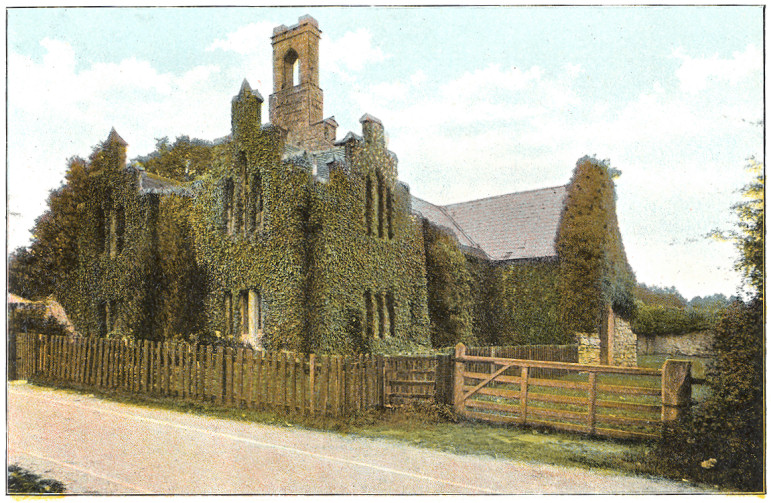
QUARR ABBEY, W. RYDE.—The distance of the Abbey from Ryde is about three miles. It is a favourite walk from Spencer Road, viâ The Lovers' Walk, past Binstead Church, through Quarr Wood. This portion is occupied as a farm, but remains of the old Abbey are scattered about, portions still standing to testify its extent and importance. The walk may be continued through the archway on to Fishbourne. In the wood the daffodil is plentiful, primroses, lungwort, and the blue iris also abound in their season. The Wood has been very extensively quarried for the limestone, with which Winchester Cathedral and many Churches were built. There are pathways through the Wood down to the shore, forming very pleasing vistas through the overhanging trees.
Spencer Road, Ryde.
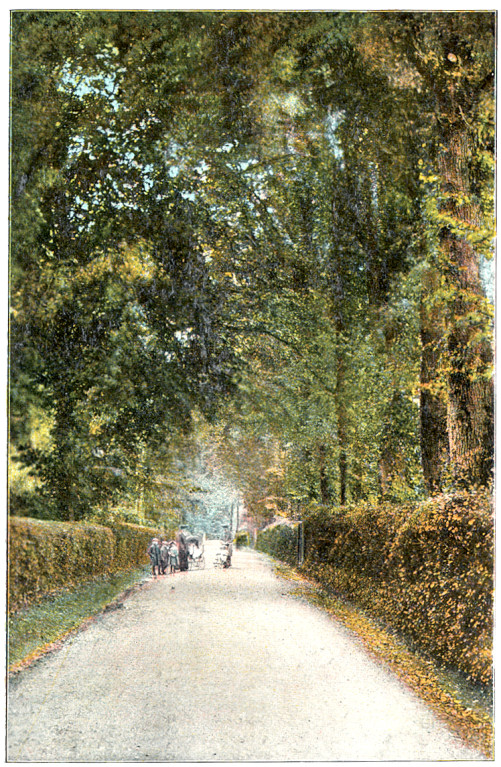
SPENCER ROAD, RYDE.—It is an advantage for a town to possess pleasant shady walks within a short distance of its main streets. Ryde is favoured in this respect. Within five minutes' walk from the Town Hall, passing St. James' Church, is Spencer Road. It is a favourite promenade, enjoyed by residents and visitors alike. A morning stroll in spring when birds are singing from every bush and tree is very delightful. It is a fine avenue extending several hundred yards and opening out into the main road to Newport. By entering the gate on the right at the junction, the walk may be continued past Binstead Church through Quarr Wood to Quarr Abbey.
Ryde, from the Pier.
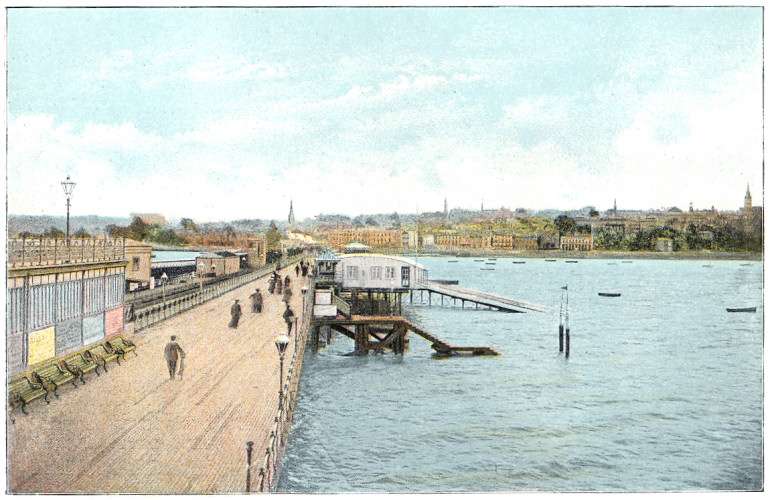
RYDE, FROM THE PIER.—The situation of the town is favourable as a principal entrance to the Island, the passage from Portsmouth by steamboat occupying about twenty minutes. The Pier (toll 2d.) is 4,000 feet in length, and is in three portions—for pedestrians and boating, electric railway, and the Isle of Wight Railway. There is a fine pavilion and bandstand at the end. Crowds of people find a never failing source of interest on the pier, yachting, boating, and fishing. On summer afternoons it is a gay and charming scene. The town is built on a gentle slope, and the houses command fine and extensive views. It has the largest population of any town in the Island, about 11,000 inhabitants.
Apley Tower, Ryde.
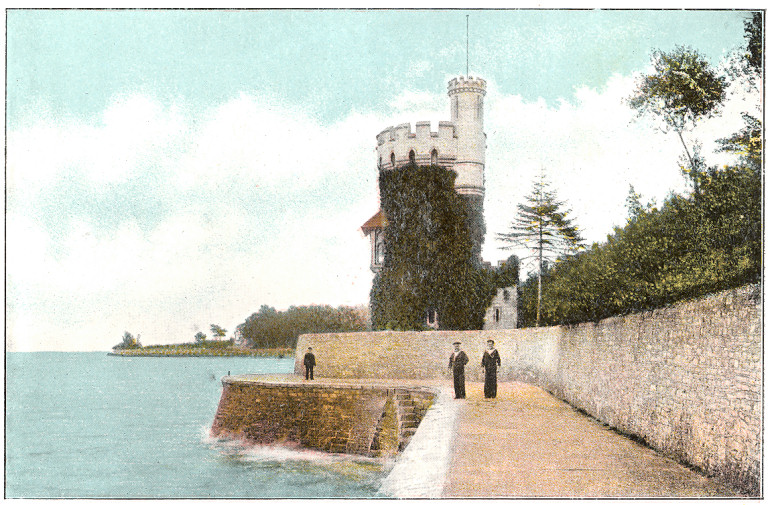
APLEY TOWER, RYDE.—Within one and a half miles of Ryde the wall is a continuation of the Esplanade in the direction of Spring Vale and Sea View. The wall furnishes a means of defence against the encroachment of the sea, as well as a thoroughfare for pedestrian traffic. Bicycles are also used on it to some extent. When the tide is out a wide stretch of sands is exposed, and crowds of children use it as a pleasure ground, finding beautiful seaweed and shells. The walk can be continued round the further point into Sea View.
Totland Bay.

TOTLAND BAY.—This charming resort has sprung into prominence and grown very fast during the last few years. Many of the houses are very picturesque and beautiful for situation, most of them with red-tiled roofs, which when toned a little more by time will be very beautiful among the trees. There is a pier, and during summer a regular service of boats from Lymington, as well as excursion traffic. The beach is steep and so you can bathe at any state of the tide. A reading-room on the shore is much patronised. The Green Cliff Walk is very delightful, and as the channel here is narrow there is a never-failing interest in the ships that pass in and out quite near. The front lacks shade in the hottest days of summer. It has great interest for the geological student, being close to Headon Hill and Alum Bay.
Sandown, looking West.
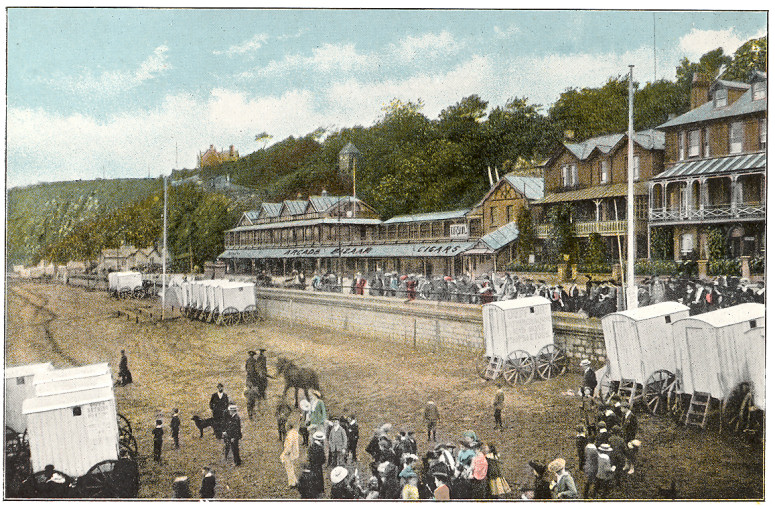
SANDOWN, LOOKING WEST.—Sandown is celebrated for its fine stretch of sands which are easy of access, and forms an extensive pleasure ground for the children. There is also a fine esplanade for promenading, which in the season is well patronised. In this view the grounds of Ferncliff can be seen behind the Arcade Bazaar, and there is a cliff path to Shanklin on the top. The picturesque fishing village lies under the cliff, slightly to the west. Sandown Railway Station is a junction with the Isle of Wight and I.W. Central Railway. Near the station is the celebrated Secondary School of the Isle of Wight Education Authority.
Tennyson's Avenue, Freshwater.
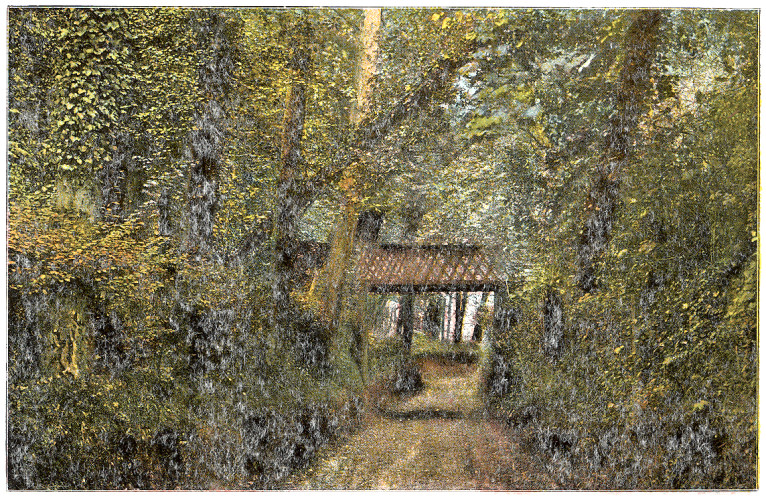
TENNYSON'S AVENUE, FRESHWATER.—Leading from the main road, near Stark's Hotel, is a lane giving access to the Downs and leading to the Avenue, across which is a small wooden bridge connecting Lord Tennyson's grounds. A quiet, secluded spot yet visited by crowds of admirers of the late Laureate. Tennyson loved retirement, and in scenes like these, surrounded with the loveliness of Nature, the breathings of his genius found full and free expression. The lane may be pursued under the bridge past the farm into the Alum Bay Road.
Freshwater Bay.
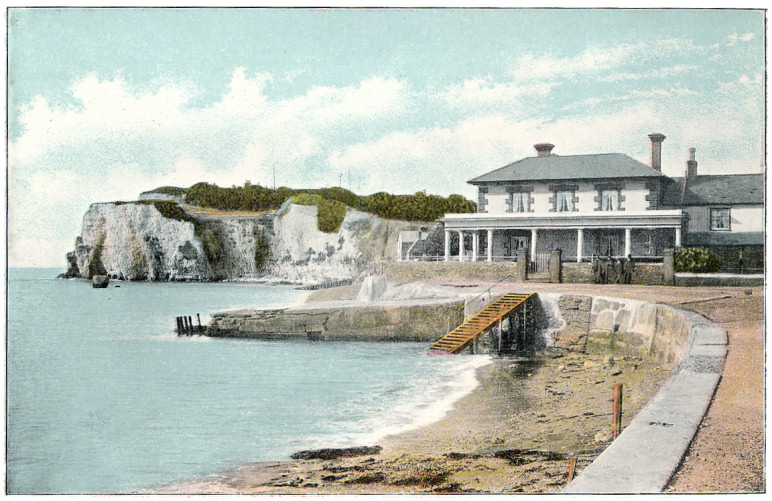
FRESHWATER BAY.—To those who desire to escape from the noise and traffic of the city, Freshwater Bay affords a delightful retreat. During the bright days of summer the sea breaks in gentle murmur on the sand and shingle of the beach, but in winter when lashed by S.W. Gales "it tumbles a billow on chalk and sand." The roar of the ocean can be heard for miles inland. The esplanade shown in the picture has been destroyed by the breakers. Temporary repairs have been effected, but a fierce controversy is still raging as to the ultimate solution of the question, how to prevent further encroachment, and the L.G.B. has been appealed to for help.
Farringford, Freshwater,
Lord Tennyson's Residence.

FARRINGFORD, FRESHWATER, LORD TENNYSON'S RESIDENCE.—The residence of the late Laureate is in the neighbourhood between freshwater Gate and Alum Bay, secluded by trees almost to invisibility. The front is covered with greenery, a fine magnolia growing round and over the front door. From under the lateral branches of a fine spreading cedar tree the Poet could look into Freshwater Bay and yet himself not be seen. The park-like grounds are pleasant to walk in, and are open to the inspection of visitors on Thursdays at certain seasons. In his poem of invitation to Rev. F. D. Maurice in 1854 he well describes it:
"Where far from smoke and noise of town,
I watch the twilight falling brown,
All round a careless order'd garden,
Close to the ridge of a noble down."
Godshill Church.
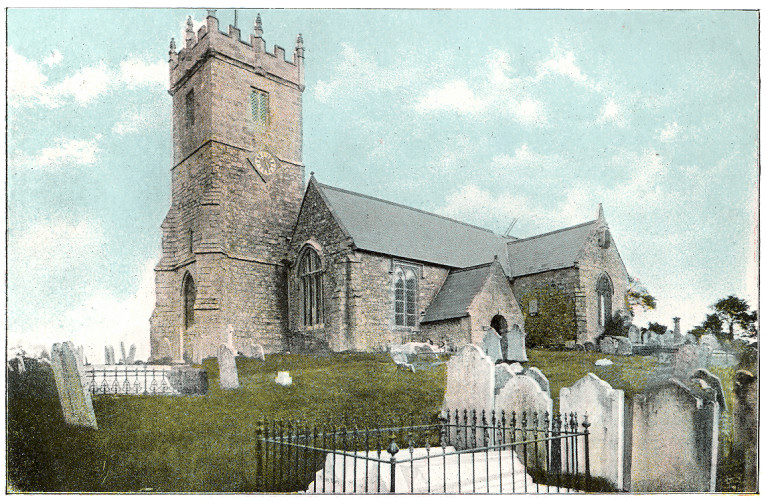
GODSHILL CHURCH.—Built in a striking and conspicuous situation, Godshill Church is visible from many distant points of the surrounding country—a good example of Early Perpendicular architecture, a cruciform structure having two equal aisles of its whole length, with a fine pinnacled tower and sancte-bell turret in the south transept gable. The tower has been recently rebuilt, having been shattered in a thunderstorm in January, 1904, when the clock face was torn out and thrown out into the churchyard. It contains monuments to the Worsley family and the tomb of Sir John Leigh; also a fine painting, of the school of Rubens, of Daniel in the Lions' Den. There are tea-gardens in the village for the accommodation of the numerous visitors who throng there from Shanklin, Sandown, and other places in the vicinity. There is also the old village inn, the Griffon.
Little Jane's Cottage,
Brading.
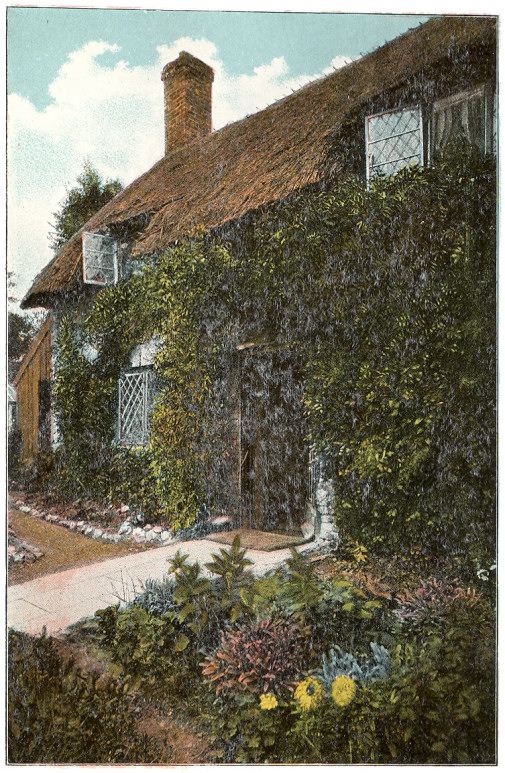
LITTLE JANE'S COTTAGE, BRADING.—This cottage still retains its original appearance with thatched roof and diamond window-panes, a real old-fashioned Isle of Wight cottage, many of which are fast disappearing. The little forecourt and garden are well kept. The greenery covering the front, of plants of great variety, from the yellow jessamine to the red fuchsia, with flowers under and around the windows, combine in completing a picture of great beauty. Here Jane the young cottager lived when Rev. Legh Richmond was Vicar of Brading in the early part of last century. Her tombstone is at the back of Brading Church.
The Sundial,
Brading.
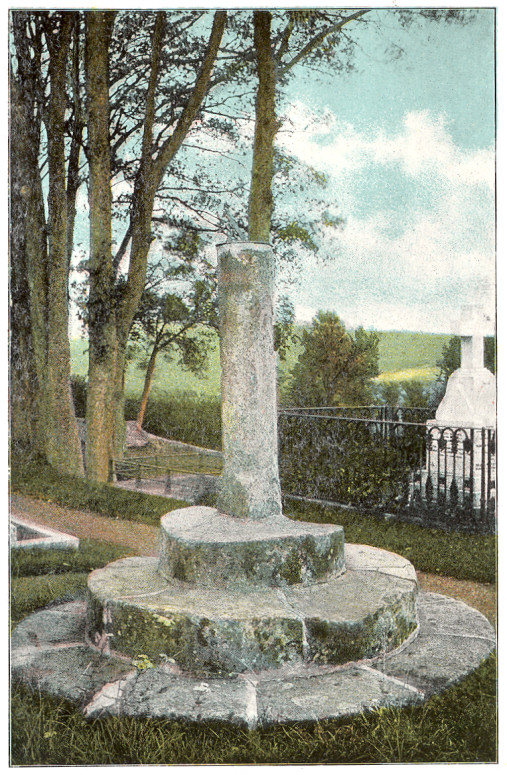
THE SUNDIAL, BRADING.—When clocks and watches were not common, a sundial was of great service to the public. This old dial, with its well-worn steps, is situated in the churchyard at the back of the Church, close to the footpath leading to the Vicarage. The view from the churchyard across to Bembridge Down is very pleasing.
The Pier, Sea View.
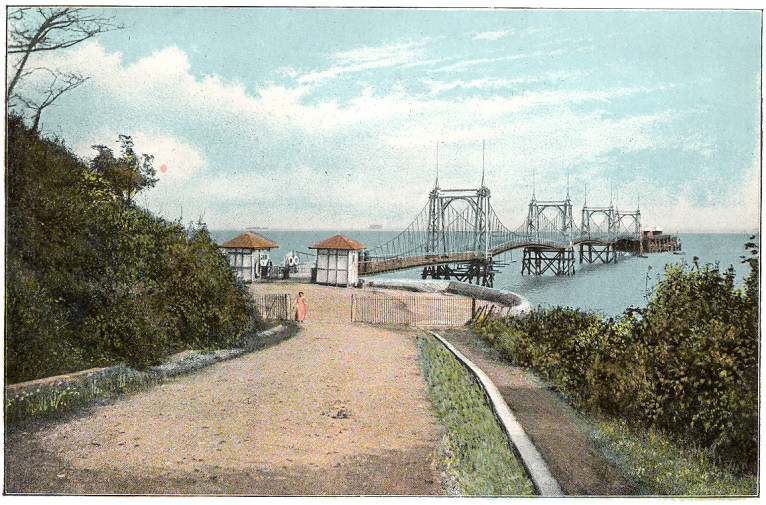
THE PIER, SEA VIEW.—This pretty little watering-place is rapidly rising into prominence as a fashionable resort. The Pier is an elegant structure suspended from piles, and affords an easy and rapid approach from Portsmouth and Southsea by steamboat, and during the summer there is a regular service of boats, as well as excursion traffic. There are also many coach and motor excursions from various parts of the island. Sea View is three miles from Ryde. Many pretty villas have recently been built to accommodate the increasing number of visitors.
View in Ventnor Park.
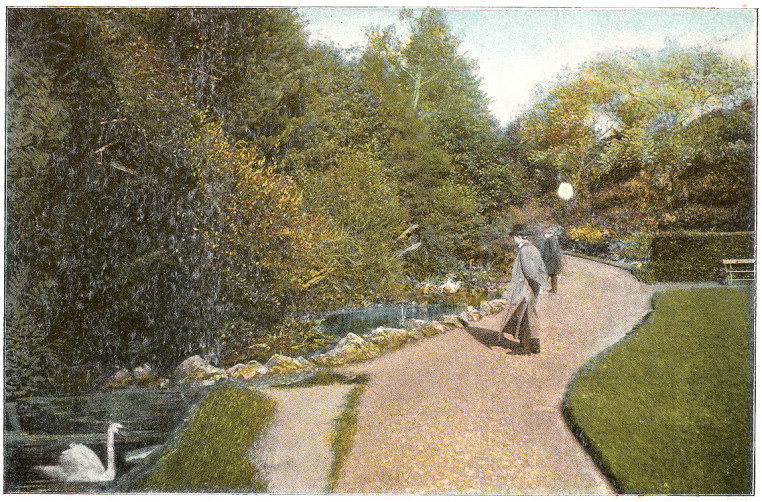
VIEW IN VENTNOR PARK.—The acquisition by the town of the site of the Park was a wise and good thing. The differences of level afford many advantages: those who like the sea breezes can walk on the upper promenade green where enchanting views of sea and land meet the eye at every point. Quiet nooks like that of the picture can be found in the lower and more sheltered grounds. The visitor can choose shade or sunshine at command. Alongside of careful culture of flowers and shrubs, wild nature also asserts itself, not having been ruthlessly suppressed.
Monk's Bay, Bonchurch.
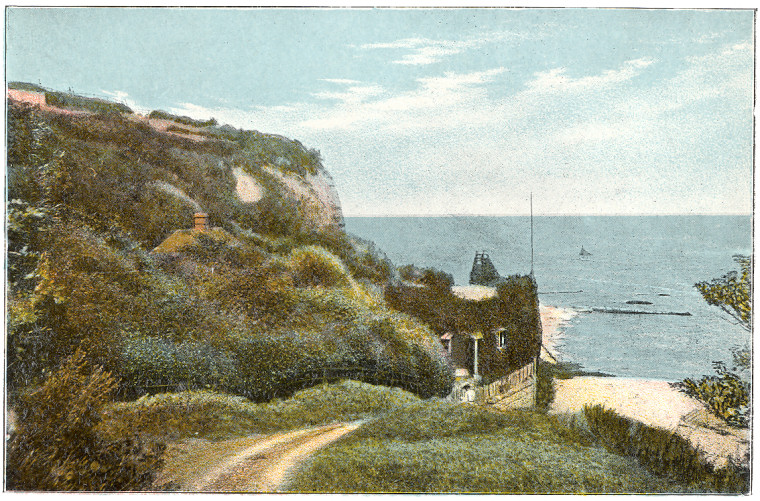
MONK'S BAY, BONCHURCH.—This quiet retreat is at the Ventnor end of the Landslip and within a short distance of Old Bonchurch. The two thatched cottages are almost grown in, and the bright red cliff which forms the prominent feature consists of the topmost beds of the lower Greensand. The lower beds behind the cottage are of geological interest from the diversity of colour in the beds. The sands are white and firm, and there are rocks and pools where children love to play. Close by is the path leading through the Landslip to Shanklin.
The Downs, Ventnor.
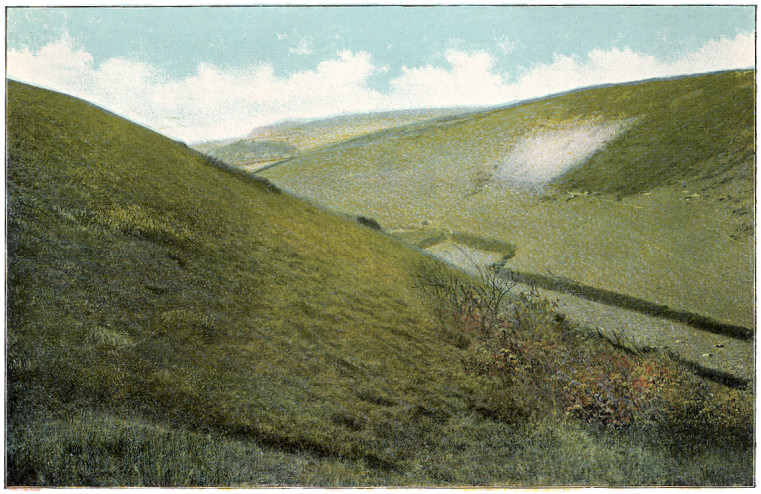
THE DOWNS, VENTNOR.—The elevation of the Downs above Ventnor affords an opportunity of enjoying most romantic and charming scenery, and of being refreshed with health-giving breezes. There are paths leading to Wroxall, also to Shanklin, unfolding a succession of views it would be difficult to rival. When the golden gorse and purple heather are in bloom it presents a glorious prospect to the vision. The footpath leading to the Downs is by the railway station, or access may be had from near the Cemetery. The prospect from the slopes of the Down toward the town and sea is very extensive and impressive.
The Cascade,
Ventnor.
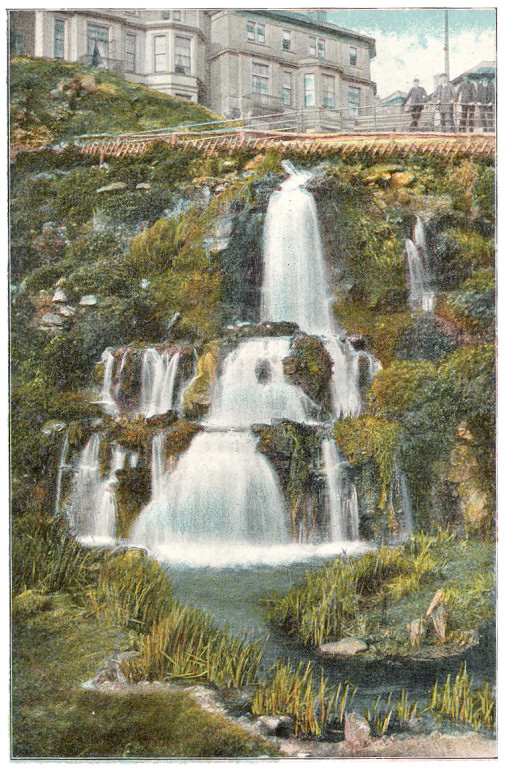
THE CASCADE, VENTNOR.—It was a happy thought when the town acquired the triangle which includes the Cascade, the water of which once went to supply Ventnor Mill. By the planting of creeping plants, of monkey musk and a number of other beautiful flowers, this neglected corner has been turned into a garden of loveliness. It is like a little corner of Switzerland, and all within sight of a busy thoroughfare. The band plays on the green below to the sound of falling water. In the heat of summer the very sound of it is refreshing.
Shanklin Esplanade
from Rylstone.
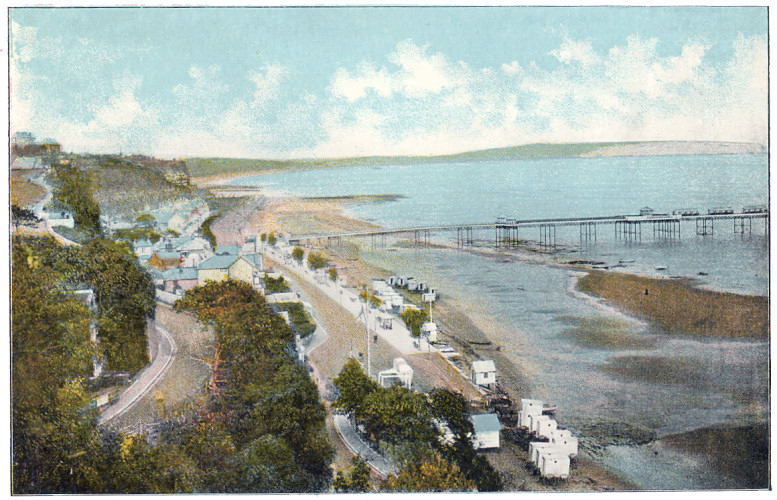
SHANKLIN ESPLANADE, FROM RYLSTONE.—This favourite view, which shews nearly the whole of Shanklin Pier, also includes in the distance the Culver Cliff. Taken from the Garden of Rylstone, overlooking the foot of the Chine, it forms a most attractive scene. The cliff pathway on the green to the right, the winding road and broad esplanade, with the wide expanse of sands, furnish a characteristic view of the principal features of Shanklin front. The level sands form a safe and pleasant bathing-ground when covered by the sea. Boating too is popular, it being within easy reach of beautiful bays in the direction of Luccombe.
The Old Church, Bonchurch.
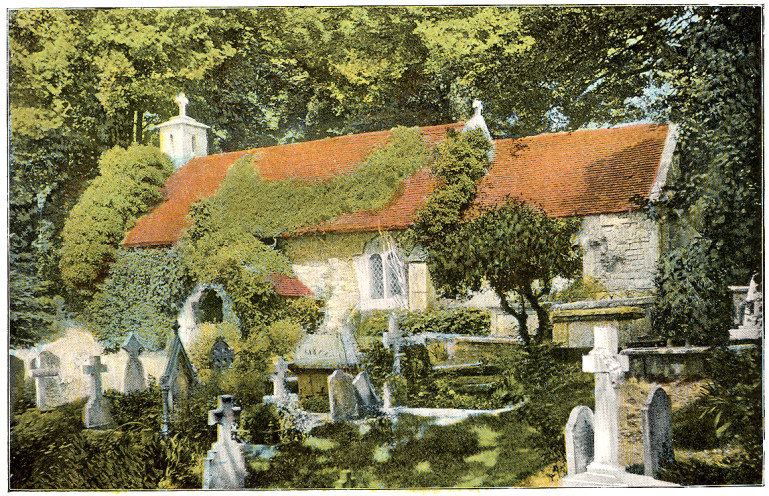
THE OLD CHURCH, BONCHURCH.—In addition to the beautiful situation and the essential loveliness of the subject, Old Bonchurch has many associations of attraction. It is no longer used for services, except an occasional funeral. In the churchyard John Sterling's grave and the grave of the Rev. J. Adams, author of the "Shadow of the Cross," interest a great many visitors, the latter having a raised horizontal cross, which casts a shadow on the stone when the sun shines. The old porch is an object of beauty, crowned with roses and honeysuckle, the red tiled roof relieved with thick masses of ivy, while over it the tall elm-trees stand, as though to shelter it from every stormy blast.
End of Project Gutenberg's Pictures in Colour of the Isle of Wight, by Various
*** END OF THIS PROJECT GUTENBERG EBOOK PICTURES IN COLOUR ***
***** This file should be named 17296-h.htm or 17296-h.zip *****
This and all associated files of various formats will be found in:
http://www.gutenberg.org/1/7/2/9/17296/
Produced by Robert J. Hall
Updated editions will replace the previous one--the old editions
will be renamed.
Creating the works from public domain print editions means that no
one owns a United States copyright in these works, so the Foundation
(and you!) can copy and distribute it in the United States without
permission and without paying copyright royalties. Special rules,
set forth in the General Terms of Use part of this license, apply to
copying and distributing Project Gutenberg-tm electronic works to
protect the PROJECT GUTENBERG-tm concept and trademark. Project
Gutenberg is a registered trademark, and may not be used if you
charge for the eBooks, unless you receive specific permission. If you
do not charge anything for copies of this eBook, complying with the
rules is very easy. You may use this eBook for nearly any purpose
such as creation of derivative works, reports, performances and
research. They may be modified and printed and given away--you may do
practically ANYTHING with public domain eBooks. Redistribution is
subject to the trademark license, especially commercial
redistribution.
*** START: FULL LICENSE ***
THE FULL PROJECT GUTENBERG LICENSE
PLEASE READ THIS BEFORE YOU DISTRIBUTE OR USE THIS WORK
To protect the Project Gutenberg-tm mission of promoting the free
distribution of electronic works, by using or distributing this work
(or any other work associated in any way with the phrase "Project
Gutenberg"), you agree to comply with all the terms of the Full Project
Gutenberg-tm License (available with this file or online at
http://gutenberg.net/license).
Section 1. General Terms of Use and Redistributing Project Gutenberg-tm
electronic works
1.A. By reading or using any part of this Project Gutenberg-tm
electronic work, you indicate that you have read, understand, agree to
and accept all the terms of this license and intellectual property
(trademark/copyright) agreement. If you do not agree to abide by all
the terms of this agreement, you must cease using and return or destroy
all copies of Project Gutenberg-tm electronic works in your possession.
If you paid a fee for obtaining a copy of or access to a Project
Gutenberg-tm electronic work and you do not agree to be bound by the
terms of this agreement, you may obtain a refund from the person or
entity to whom you paid the fee as set forth in paragraph 1.E.8.
1.B. "Project Gutenberg" is a registered trademark. It may only be
used on or associated in any way with an electronic work by people who
agree to be bound by the terms of this agreement. There are a few
things that you can do with most Project Gutenberg-tm electronic works
even without complying with the full terms of this agreement. See
paragraph 1.C below. There are a lot of things you can do with Project
Gutenberg-tm electronic works if you follow the terms of this agreement
and help preserve free future access to Project Gutenberg-tm electronic
works. See paragraph 1.E below.
1.C. The Project Gutenberg Literary Archive Foundation ("the Foundation"
or PGLAF), owns a compilation copyright in the collection of Project
Gutenberg-tm electronic works. Nearly all the individual works in the
collection are in the public domain in the United States. If an
individual work is in the public domain in the United States and you are
located in the United States, we do not claim a right to prevent you from
copying, distributing, performing, displaying or creating derivative
works based on the work as long as all references to Project Gutenberg
are removed. Of course, we hope that you will support the Project
Gutenberg-tm mission of promoting free access to electronic works by
freely sharing Project Gutenberg-tm works in compliance with the terms of
this agreement for keeping the Project Gutenberg-tm name associated with
the work. You can easily comply with the terms of this agreement by
keeping this work in the same format with its attached full Project
Gutenberg-tm License when you share it without charge with others.
1.D. The copyright laws of the place where you are located also govern
what you can do with this work. Copyright laws in most countries are in
a constant state of change. If you are outside the United States, check
the laws of your country in addition to the terms of this agreement
before downloading, copying, displaying, performing, distributing or
creating derivative works based on this work or any other Project
Gutenberg-tm work. The Foundation makes no representations concerning
the copyright status of any work in any country outside the United
States.
1.E. Unless you have removed all references to Project Gutenberg:
1.E.1. The following sentence, with active links to, or other immediate
access to, the full Project Gutenberg-tm License must appear prominently
whenever any copy of a Project Gutenberg-tm work (any work on which the
phrase "Project Gutenberg" appears, or with which the phrase "Project
Gutenberg" is associated) is accessed, displayed, performed, viewed,
copied or distributed:
This eBook is for the use of anyone anywhere at no cost and with
almost no restrictions whatsoever. You may copy it, give it away or
re-use it under the terms of the Project Gutenberg License included
with this eBook or online at www.gutenberg.net
1.E.2. If an individual Project Gutenberg-tm electronic work is derived
from the public domain (does not contain a notice indicating that it is
posted with permission of the copyright holder), the work can be copied
and distributed to anyone in the United States without paying any fees
or charges. If you are redistributing or providing access to a work
with the phrase "Project Gutenberg" associated with or appearing on the
work, you must comply either with the requirements of paragraphs 1.E.1
through 1.E.7 or obtain permission for the use of the work and the
Project Gutenberg-tm trademark as set forth in paragraphs 1.E.8 or
1.E.9.
1.E.3. If an individual Project Gutenberg-tm electronic work is posted
with the permission of the copyright holder, your use and distribution
must comply with both paragraphs 1.E.1 through 1.E.7 and any additional
terms imposed by the copyright holder. Additional terms will be linked
to the Project Gutenberg-tm License for all works posted with the
permission of the copyright holder found at the beginning of this work.
1.E.4. Do not unlink or detach or remove the full Project Gutenberg-tm
License terms from this work, or any files containing a part of this
work or any other work associated with Project Gutenberg-tm.
1.E.5. Do not copy, display, perform, distribute or redistribute this
electronic work, or any part of this electronic work, without
prominently displaying the sentence set forth in paragraph 1.E.1 with
active links or immediate access to the full terms of the Project
Gutenberg-tm License.
1.E.6. You may convert to and distribute this work in any binary,
compressed, marked up, nonproprietary or proprietary form, including any
word processing or hypertext form. However, if you provide access to or
distribute copies of a Project Gutenberg-tm work in a format other than
"Plain Vanilla ASCII" or other format used in the official version
posted on the official Project Gutenberg-tm web site (www.gutenberg.net),
you must, at no additional cost, fee or expense to the user, provide a
copy, a means of exporting a copy, or a means of obtaining a copy upon
request, of the work in its original "Plain Vanilla ASCII" or other
form. Any alternate format must include the full Project Gutenberg-tm
License as specified in paragraph 1.E.1.
1.E.7. Do not charge a fee for access to, viewing, displaying,
performing, copying or distributing any Project Gutenberg-tm works
unless you comply with paragraph 1.E.8 or 1.E.9.
1.E.8. You may charge a reasonable fee for copies of or providing
access to or distributing Project Gutenberg-tm electronic works provided
that
- You pay a royalty fee of 20% of the gross profits you derive from
the use of Project Gutenberg-tm works calculated using the method
you already use to calculate your applicable taxes. The fee is
owed to the owner of the Project Gutenberg-tm trademark, but he
has agreed to donate royalties under this paragraph to the
Project Gutenberg Literary Archive Foundation. Royalty payments
must be paid within 60 days following each date on which you
prepare (or are legally required to prepare) your periodic tax
returns. Royalty payments should be clearly marked as such and
sent to the Project Gutenberg Literary Archive Foundation at the
address specified in Section 4, "Information about donations to
the Project Gutenberg Literary Archive Foundation."
- You provide a full refund of any money paid by a user who notifies
you in writing (or by e-mail) within 30 days of receipt that s/he
does not agree to the terms of the full Project Gutenberg-tm
License. You must require such a user to return or
destroy all copies of the works possessed in a physical medium
and discontinue all use of and all access to other copies of
Project Gutenberg-tm works.
- You provide, in accordance with paragraph 1.F.3, a full refund of any
money paid for a work or a replacement copy, if a defect in the
electronic work is discovered and reported to you within 90 days
of receipt of the work.
- You comply with all other terms of this agreement for free
distribution of Project Gutenberg-tm works.
1.E.9. If you wish to charge a fee or distribute a Project Gutenberg-tm
electronic work or group of works on different terms than are set
forth in this agreement, you must obtain permission in writing from
both the Project Gutenberg Literary Archive Foundation and Michael
Hart, the owner of the Project Gutenberg-tm trademark. Contact the
Foundation as set forth in Section 3 below.
1.F.
1.F.1. Project Gutenberg volunteers and employees expend considerable
effort to identify, do copyright research on, transcribe and proofread
public domain works in creating the Project Gutenberg-tm
collection. Despite these efforts, Project Gutenberg-tm electronic
works, and the medium on which they may be stored, may contain
"Defects," such as, but not limited to, incomplete, inaccurate or
corrupt data, transcription errors, a copyright or other intellectual
property infringement, a defective or damaged disk or other medium, a
computer virus, or computer codes that damage or cannot be read by
your equipment.
1.F.2. LIMITED WARRANTY, DISCLAIMER OF DAMAGES - Except for the "Right
of Replacement or Refund" described in paragraph 1.F.3, the Project
Gutenberg Literary Archive Foundation, the owner of the Project
Gutenberg-tm trademark, and any other party distributing a Project
Gutenberg-tm electronic work under this agreement, disclaim all
liability to you for damages, costs and expenses, including legal
fees. YOU AGREE THAT YOU HAVE NO REMEDIES FOR NEGLIGENCE, STRICT
LIABILITY, BREACH OF WARRANTY OR BREACH OF CONTRACT EXCEPT THOSE
PROVIDED IN PARAGRAPH F3. YOU AGREE THAT THE FOUNDATION, THE
TRADEMARK OWNER, AND ANY DISTRIBUTOR UNDER THIS AGREEMENT WILL NOT BE
LIABLE TO YOU FOR ACTUAL, DIRECT, INDIRECT, CONSEQUENTIAL, PUNITIVE OR
INCIDENTAL DAMAGES EVEN IF YOU GIVE NOTICE OF THE POSSIBILITY OF SUCH
DAMAGE.
1.F.3. LIMITED RIGHT OF REPLACEMENT OR REFUND - If you discover a
defect in this electronic work within 90 days of receiving it, you can
receive a refund of the money (if any) you paid for it by sending a
written explanation to the person you received the work from. If you
received the work on a physical medium, you must return the medium with
your written explanation. The person or entity that provided you with
the defective work may elect to provide a replacement copy in lieu of a
refund. If you received the work electronically, the person or entity
providing it to you may choose to give you a second opportunity to
receive the work electronically in lieu of a refund. If the second copy
is also defective, you may demand a refund in writing without further
opportunities to fix the problem.
1.F.4. Except for the limited right of replacement or refund set forth
in paragraph 1.F.3, this work is provided to you 'AS-IS' WITH NO OTHER
WARRANTIES OF ANY KIND, EXPRESS OR IMPLIED, INCLUDING BUT NOT LIMITED TO
WARRANTIES OF MERCHANTIBILITY OR FITNESS FOR ANY PURPOSE.
1.F.5. Some states do not allow disclaimers of certain implied
warranties or the exclusion or limitation of certain types of damages.
If any disclaimer or limitation set forth in this agreement violates the
law of the state applicable to this agreement, the agreement shall be
interpreted to make the maximum disclaimer or limitation permitted by
the applicable state law. The invalidity or unenforceability of any
provision of this agreement shall not void the remaining provisions.
1.F.6. INDEMNITY - You agree to indemnify and hold the Foundation, the
trademark owner, any agent or employee of the Foundation, anyone
providing copies of Project Gutenberg-tm electronic works in accordance
with this agreement, and any volunteers associated with the production,
promotion and distribution of Project Gutenberg-tm electronic works,
harmless from all liability, costs and expenses, including legal fees,
that arise directly or indirectly from any of the following which you do
or cause to occur: (a) distribution of this or any Project Gutenberg-tm
work, (b) alteration, modification, or additions or deletions to any
Project Gutenberg-tm work, and (c) any Defect you cause.
Section 2. Information about the Mission of Project Gutenberg-tm
Project Gutenberg-tm is synonymous with the free distribution of
electronic works in formats readable by the widest variety of computers
including obsolete, old, middle-aged and new computers. It exists
because of the efforts of hundreds of volunteers and donations from
people in all walks of life.
Volunteers and financial support to provide volunteers with the
assistance they need, is critical to reaching Project Gutenberg-tm's
goals and ensuring that the Project Gutenberg-tm collection will
remain freely available for generations to come. In 2001, the Project
Gutenberg Literary Archive Foundation was created to provide a secure
and permanent future for Project Gutenberg-tm and future generations.
To learn more about the Project Gutenberg Literary Archive Foundation
and how your efforts and donations can help, see Sections 3 and 4
and the Foundation web page at http://www.pglaf.org.
Section 3. Information about the Project Gutenberg Literary Archive
Foundation
The Project Gutenberg Literary Archive Foundation is a non profit
501(c)(3) educational corporation organized under the laws of the
state of Mississippi and granted tax exempt status by the Internal
Revenue Service. The Foundation's EIN or federal tax identification
number is 64-6221541. Its 501(c)(3) letter is posted at
http://pglaf.org/fundraising. Contributions to the Project Gutenberg
Literary Archive Foundation are tax deductible to the full extent
permitted by U.S. federal laws and your state's laws.
The Foundation's principal office is located at 4557 Melan Dr. S.
Fairbanks, AK, 99712., but its volunteers and employees are scattered
throughout numerous locations. Its business office is located at
809 North 1500 West, Salt Lake City, UT 84116, (801) 596-1887, email
[email protected]. Email contact links and up to date contact
information can be found at the Foundation's web site and official
page at http://pglaf.org
For additional contact information:
Dr. Gregory B. Newby
Chief Executive and Director
[email protected]
Section 4. Information about Donations to the Project Gutenberg
Literary Archive Foundation
Project Gutenberg-tm depends upon and cannot survive without wide
spread public support and donations to carry out its mission of
increasing the number of public domain and licensed works that can be
freely distributed in machine readable form accessible by the widest
array of equipment including outdated equipment. Many small donations
($1 to $5,000) are particularly important to maintaining tax exempt
status with the IRS.
The Foundation is committed to complying with the laws regulating
charities and charitable donations in all 50 states of the United
States. Compliance requirements are not uniform and it takes a
considerable effort, much paperwork and many fees to meet and keep up
with these requirements. We do not solicit donations in locations
where we have not received written confirmation of compliance. To
SEND DONATIONS or determine the status of compliance for any
particular state visit http://pglaf.org
While we cannot and do not solicit contributions from states where we
have not met the solicitation requirements, we know of no prohibition
against accepting unsolicited donations from donors in such states who
approach us with offers to donate.
International donations are gratefully accepted, but we cannot make
any statements concerning tax treatment of donations received from
outside the United States. U.S. laws alone swamp our small staff.
Please check the Project Gutenberg Web pages for current donation
methods and addresses. Donations are accepted in a number of other
ways including including checks, online payments and credit card
donations. To donate, please visit: http://pglaf.org/donate
Section 5. General Information About Project Gutenberg-tm electronic
works.
Professor Michael S. Hart is the originator of the Project Gutenberg-tm
concept of a library of electronic works that could be freely shared
with anyone. For thirty years, he produced and distributed Project
Gutenberg-tm eBooks with only a loose network of volunteer support.
Project Gutenberg-tm eBooks are often created from several printed
editions, all of which are confirmed as Public Domain in the U.S.
unless a copyright notice is included. Thus, we do not necessarily
keep eBooks in compliance with any particular paper edition.
Most people start at our Web site which has the main PG search facility:
http://www.gutenberg.net
This Web site includes information about Project Gutenberg-tm,
including how to make donations to the Project Gutenberg Literary
Archive Foundation, how to help produce our new eBooks, and how to
subscribe to our email newsletter to hear about new eBooks.